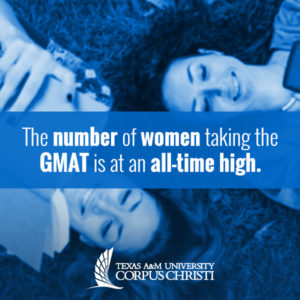Women continue to set records for taking the GMAT (Graduate Management Admission Test), which is, according to the Graduate Management Admissions Council’s (GMAC) Alumni Perspectives Survey, “an important part of the admissions process for more than 6,100 graduate management programs around the world.” The number of women taking the GMAT is at an all-time high. Earning an MBA (Master of Business Administration) can help women accelerate their careers by boosting their credentials and skills and expanding their professional networks. Women with MBAs also can earn better salaries than those with only undergraduate degrees. According to GMAC’s Global Management Education Graduate Survey, women ages 28 to 34 in the class of 2014 and across all types of graduate business programs reported earning a median starting salary of $79,000.
Business schools, “organizations and individuals are working to ensure more women pursue [MBAs]” (mba.com), and the efforts many graduate business programs are making to recruit more qualified female applicants seem to be paying off. Recent data published in the GMAC report Women and Graduate Management Education reveal that “of the total 243,529 test takers, 105,476 women took the GMAT exam in the 2014 testing year ending June 30, 2014.” This represents 43.3 percent of the total, a new record high for women. The report goes on to reveal that testing year 2014 “marked the sixth year in a row that women broke the 100,000 mark in the number of GMAT exams taken, and reflects the lowest male-female ratio (1.31) in GMAT history. It also reflects a 3.7 percent average annual growth rate in number of female examinees over the past 10 testing years, nearly double the growth rate for men.”
Not only are more women sitting for the GMAT exam, the number of younger women taking the test is increasing. Of all GMAT exams women took in 2014, more than half, or 59 percent, were taken by women younger than 25 years of age. By age range, women make up a majority (52 percent) of the test takers younger than 25.
In its 16th annual Application Trends Survey (2015), GMAC reported that demand for “flexible MBA programs, which blend the full-time and part-time options” and online MBA programs in the United States have grown in popularity, with 54 percent and 50 percent, respectively, of programs reporting increases in applications. More than half of online MBA programs are seeing an increase in the volume of women’s applications (52 percent). In addition, class sizes in online MBA programs are increasing from a median 61 seats in the 2014-2015 class to 85 seats in the 2015-2016 class, giving women an opportunity to take those extra seats.
The 2015 GMAC survey spotlights women applicants in a variety of programs. The organization says “more than half of the following program formats report growing application volume for women in 2015 compared with last year: full-time two-year MBA (51% of programs), full-time one-year MBA (50%), executive MBA (50%), online MBA (55%), Master in Management (55%), Master of Finance (56%), Master of Accounting (57%), and Master in Marketing and Communications (60%).”
What Do Women Who Take the GMAT Go on to Do?
Women find post-degree jobs quickly, according to GMAC’s Alumni Perspectives Survey, conducted in October 2014. Eighty-two percent of women in the class of 2014 received a job offer within three months after graduation. The top industries of employment for women MBA and management degree-holders from the class of 2014 were products and services (20 percent), consulting (18 percent) and finance/accounting (16 percent). Their top job functions were finance/accounting (26 percent), marketing/sales (25 percent) and consulting (16 percent). Nearly three out of four female business school graduates from the class of 2014 were hired for mid-level positions. Further, according to GMAC’s Women and Graduate Management Education survey, the majority of all women and men surveyed “say their business degree provided a competitive advantage and improved their chances of finding a job.” Most women said they felt prepared for the job market and saw improved salary opportunities.
Learn more about the Texas A&M-Corpus Christi online MBA program.
Sources:
http://newscenter.gmac.com/press-releases/majority-of-full-time-mba-programs-worldwide-repor-1218449
http://www.bloomberg.com/bw/articles/2013-03-05/women-taking-gmat-in-record-numbers
http://www.gmac.com/~/media/Files/gmac/Research/diversity-enrollment/gmac-dtg-gme-and-women-2013.pdf

